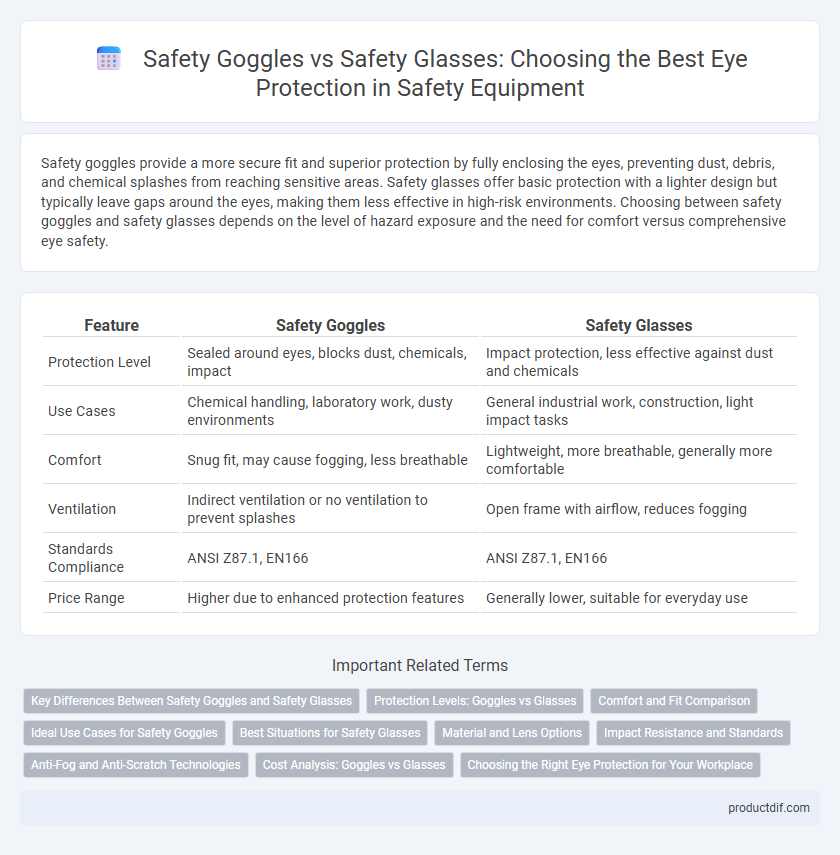Safety goggles provide a more secure fit and superior protection by fully enclosing the eyes, preventing dust, debris, and chemical splashes from reaching sensitive areas. Safety glasses offer basic protection with a lighter design but typically leave gaps around the eyes, making them less effective in high-risk environments. Choosing between safety goggles and safety glasses depends on the level of hazard exposure and the need for comfort versus comprehensive eye safety.
Table of Comparison
| Feature | Safety Goggles | Safety Glasses |
|---|---|---|
| Protection Level | Sealed around eyes, blocks dust, chemicals, impact | Impact protection, less effective against dust and chemicals |
| Use Cases | Chemical handling, laboratory work, dusty environments | General industrial work, construction, light impact tasks |
| Comfort | Snug fit, may cause fogging, less breathable | Lightweight, more breathable, generally more comfortable |
| Ventilation | Indirect ventilation or no ventilation to prevent splashes | Open frame with airflow, reduces fogging |
| Standards Compliance | ANSI Z87.1, EN166 | ANSI Z87.1, EN166 |
| Price Range | Higher due to enhanced protection features | Generally lower, suitable for everyday use |
Key Differences Between Safety Goggles and Safety Glasses
Safety goggles provide a sealed fit around the eyes, offering superior protection against dust, chemicals, and impact hazards, while safety glasses feature open designs with side shields primarily for impact resistance. Goggles are ideal in environments requiring splash or chemical protection, ensuring no particulate matter reaches the eyes, whereas safety glasses are more suitable for general eye protection in low-risk settings. The choice between them depends on specific workplace hazards, with goggles favored for comprehensive coverage and glasses for lightweight comfort.
Protection Levels: Goggles vs Glasses
Safety goggles provide a higher level of protection compared to safety glasses by forming a sealed barrier around the eyes, effectively shielding against dust, chemical splashes, and impact hazards. Safety glasses offer basic protection, primarily guarding against flying debris and light impact but lack the full coverage and side protection found in goggles. Choosing between goggles and glasses depends on the specific safety risks present in the work environment and the need for comprehensive eye protection.
Comfort and Fit Comparison
Safety goggles provide a secure, airtight seal around the eyes, offering enhanced protection but can feel bulkier and less breathable compared to safety glasses. Safety glasses are designed for lightweight comfort with adjustable features that promote better ventilation and a more customizable fit for extended wear. Selecting between the two depends on the required protection level and wearer preference for comfort during prolonged use.
Ideal Use Cases for Safety Goggles
Safety goggles provide a secure seal around the eyes, making them ideal for environments with airborne particles, chemical splashes, or hazardous liquids, where protection from both impact and contaminants is essential. They are commonly used in laboratories, construction sites, and medical settings to prevent exposure to harmful substances. Compared to safety glasses, goggles offer superior protection in situations requiring a tight barrier against dust, fumes, and splashes.
Best Situations for Safety Glasses
Safety glasses provide optimal protection in environments with low to moderate impact risks, such as general laboratory work, woodworking, and indoor construction. Their lightweight design and clear lenses allow for extended wear and better peripheral vision during tasks requiring detail orientation. Ideal for protecting against dust, debris, and minor chemical splashes, safety glasses are preferred when comfort and visibility are essential without the need for full seal protection.
Material and Lens Options
Safety goggles are typically made from durable, chemical-resistant polyurethane or PVC, featuring impact-resistant polycarbonate lenses that provide full-seal protection against dust, debris, and liquid splashes. Safety glasses often use lightweight nylon or metal frames with polycarbonate or glass lenses, designed for comfort and basic impact protection but lacking complete side shielding. Lens options for goggles include anti-fog and UV protection coatings, while safety glasses offer interchangeable lenses with varying tints and anti-scratch finishes to suit different work environments.
Impact Resistance and Standards
Safety goggles offer superior impact resistance compared to safety glasses, meeting ANSI Z87.1 high-impact standards to protect against flying debris and chemical splashes. Safety glasses typically comply with basic ANSI Z87.1 standards but provide less comprehensive coverage, making them suitable for lower-risk environments. Choosing equipment that aligns with specific OSHA requirements ensures adequate eye protection for various industrial and laboratory settings.
Anti-Fog and Anti-Scratch Technologies
Safety goggles incorporate advanced anti-fog coatings to maintain clear vision in humid or high-temperature environments, making them essential for prolonged use in laboratories and industrial settings. Safety glasses often feature durable anti-scratch treatments that protect lenses from abrasions caused by debris or frequent cleaning, ensuring long-lasting clarity. Both designs utilize specialized technologies to enhance user safety, with goggles prioritizing fog resistance and glasses focusing on scratch durability.
Cost Analysis: Goggles vs Glasses
Safety goggles typically incur higher upfront costs than safety glasses due to their more comprehensive protective features, such as sealed edges and impact-resistant materials, which justify the investment in high-risk work environments. Safety glasses offer a cost-effective solution with lower initial prices and adequate protection for general tasks, but may require more frequent replacement due to reduced durability and less coverage. When calculating total cost of ownership, factors like replacement frequency, comfort linked to wear-time, and specific job hazards influence whether the premium price of goggles provides long-term savings over safety glasses.
Choosing the Right Eye Protection for Your Workplace
Safety goggles provide a secure, sealed fit around the eyes, making them ideal for environments with chemical splashes, dust, or airborne particles, while safety glasses offer lightweight protection against impact hazards like flying debris and sparks. Assessing workplace risks, such as exposure to hazardous liquids or high-velocity projectiles, guides the choice between goggles and glasses to ensure maximum eye safety. Compliance with OSHA and ANSI standards is critical when selecting eye protection to reduce workplace injuries and maintain regulatory adherence.
Safety goggles vs Safety glasses Infographic

 productdif.com
productdif.com